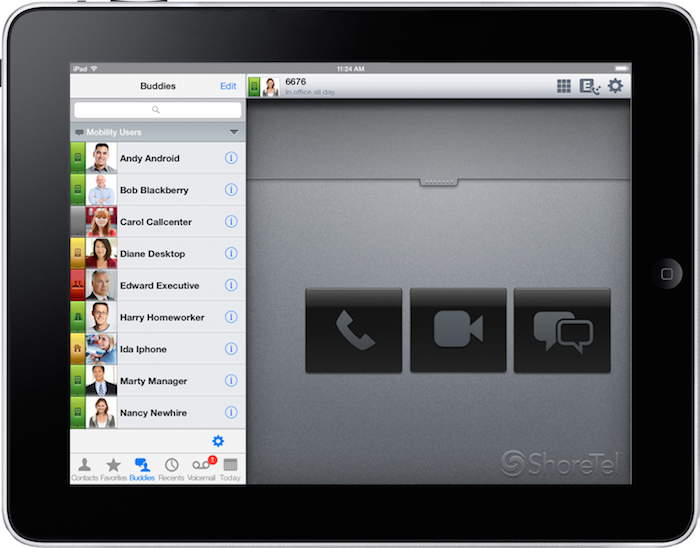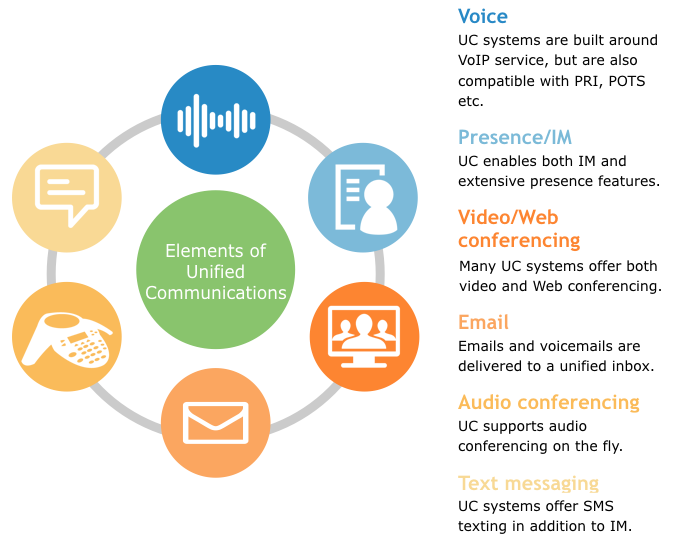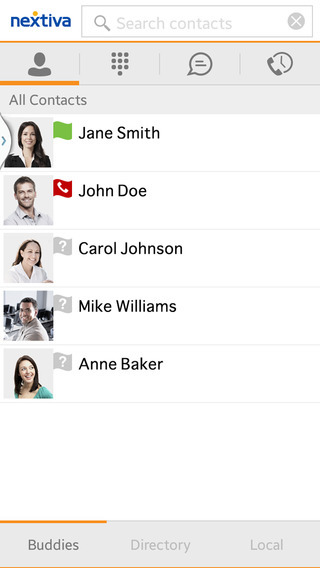Find the best UCaaS Providers
Compare Products
Showing 1 - 20 of 227 products
Sort by
Reviews: Sorts listings by the number of user reviews we have published, greatest to least.
Sponsored: Sorts listings by software vendors running active bidding campaigns, from the highest to lowest bid. Vendors who have paid for placement have a ‘Visit Website’ button, whereas unpaid vendors have a ‘Learn More’ button.
Avg Rating: Sorts listings by overall star rating based on user reviews, highest to lowest.
A to Z: Sorts listings by product name from A to Z.
Nextiva
Nextiva
Nextiva brings customers and teams closer by connecting conversations in one AI-powered platform. We connect businesses to all of their conversations, helping them understand their customers in real-time to create personalized exp...Read more about Nextiva
GoTo Connect
GoTo Connect
GoTo Connect is the all-in-one phone, meeting and messaging software built for SMBs. It boasts an enterprise-class phone system with 100+ features with inclusive minutes for local, long distance & international calls; video and au...Read more about GoTo Connect
Comm-unity
Comm-unity
Comm-unity by NetFortris (formerly Fonality) is a cloud-based communication and collaboration business phone system that caters to all business sizes. Comm-unity scales easily as your business grows, always works when you need it,...Read more about Comm-unity
RingCentral MVP
RingCentral MVP
RingEX is a cloud-based business communications solution that offers tools for Messaging, Video and Phone. Core features of the solution include conferencing, auto-recording and unlimited long-distance and local calling. RingEX ...Read more about RingCentral MVP
MiVoice Business Solution
MiVoice Business Solution
MiCloud Connect (formerly ShoreTel) is a cloud-based VoIP phone system that offers collaboration and conferencing tools to enable information flow within the organization. The solution enables system administrators to manage use...Read more about MiVoice Business Solution
Vonage Business Communications
Vonage Business Communications
Vonage Business Communications is a good option for small-, medium-, and enterprise-level businesses that need a scalable, easy-to-use VoIP platform with premium voice clarity and a wide array of solutions for specific business ne...Read more about Vonage Business Communications
Avaya Cloud Office
Avaya Cloud Office
Avaya Cloud Office is a cloud-based communications and collaboration solution designed for small to midsize businesses. It features auto dialing, conferencing, screen sharing, instant messaging, and more. Avaya Cloud Office is av...Read more about Avaya Cloud Office
Ooma Office
Ooma Office
Ooma Office is a cloud-based voice + video solution suitable for businesses of all sizes. The platform includes a full suite of business phone features designed to deliver a flawless communications experience and advance team coll...Read more about Ooma Office
3CX
3CX
3CX Phone System is an open standards communications solution, suitable for any sized business that wants all the features of an advanced contact center at a fraction of the cost. 3CX can take your business communications to the n...Read more about 3CX
BroadVoice Cloud PBX
BroadVoice Cloud PBX
BroadVoice b-Hive helps call and collaborate from anywhere with a single cloud communication solution that unifies business phones, video conferencing, texting and collaboration under a single phone number. Untether your team fro...Read more about BroadVoice Cloud PBX
VirtualPBX
VirtualPBX
VirtualPBX is a cloud-based phone solution that caters to all-sized businesses. VirtualPBX enables companies to streamline and improve communications with features such as unlimited minutes, video conferencing, business SMS, auto-...Read more about VirtualPBX
VoiceMaxx CE
VoiceMaxx CE
VoiceMaxx CE (Cisco Edition) by West IP Communications is a cloud-based enterprise PBX solution. Key features include inbound and outbound calling capability, call control functionalities, personal conferencing and 'Mobile Connect...Read more about VoiceMaxx CE
CloudCall
CloudCall
CloudCall is the only communications software dedicated to businesses who use CRMs. By capturing all calls and communications, and saving them into the CRM contact records, CloudCall helps businesses make more insightful decisions...Read more about CloudCall
Masergy UCaaS
Masergy UCaaS
Masergy is a provider of cloud-based unified communications as a service (UCaaS). Some of the solution's features include conferencing, instant messaging and video calling. It can be integrated with businesses' existing on-premise...Read more about Masergy UCaaS
Business VoiceEdge
Business VoiceEdge
Comcast offers a cloud-based phone system known as Business VoiceEdge. Business VoiceEdge bundles SIP trunking service with hosted PBX applications. The PBX applications enable directory-based routing of inbound calls and communic...Read more about Business VoiceEdge
Line2 Pro
Line2 Pro
Line2 is a cloud-based phone system that provides assistance in calling and messaging. It is suitable for small businesses. Line2 offers standard PBX features, including a dial-by-name directory, an auto attendant, call forwarding...Read more about Line2 Pro
Telzio
Telzio
Telzio is a cloud communications provider that offers small business phone system. It includes trunking that allows professionals to connect calls with the phone network so businesses don’t have to look for a third-party SIP provi...Read more about Telzio
Fuze
Fuze
Fuze is an online meeting solution that works across a range of devices and integrates with traditional video conferencing systems. Users receive audio conferencing, video conferencing, screen sharing and web conferencing function...Read more about Fuze
Ring.io
Ring.io
Ringio is a cloud-based call center management solution that features a CRM dialer, call routing, analytics and more. It’s used by sales teams in many industries such as healthcare, media, non-profit and banking. The system c...Read more about Ring.io
UniVoIP
UniVoIP
Cloud Voice for Microsoft Teams from UniVoIP Why Use Microsoft Teams as a Phone System? ● You already have M365, so maximize your existing Microsoft investment - and cut costs drastically. ● True Unified Communications - busine...Read more about UniVoIP
Popular Comparisons
Buyers Guide
Last Updated: March 16, 2023“Unified communications” (UC) is a buzzword for technologies that connect voice, email, text messaging, instant messaging (IM) and other business communication channels through intuitive user interfaces and software integrations. UC software systems focus communications functionality around the end user and provide a consistent experience across multiple devices (laptops, IP phones, smartphones, tablets, headsets etc.).
Unified-Communications-as-a-Service (UCaaS), meanwhile, is simply a term for cloud-based UC, which is typically delivered on a subscription basis (in other words, you pay per-month rates for user licenses instead of one-time license fees).
This guide is intended to help you research UCaaS solutions for your organization. It covers the following topics:
What Are Unified Communications and UCaaS?
On-Premise UC, UCaaS and Hybrid Deployment Models
What Are Unified Communications and UCaaS?
Traditional business phone systems primarily focused on managing the voice channel. This created a disjointed experience for employees who had to use other applications for email, instant messaging and so on. Moreover, these systems didn’t offer the flexible configuration settings users need to personalize their various communication methods. Even worse, legacy phone systems were difficult to integrate with other types of business software.
UC emerged around the turn of the millennium, as phone systems designed for VoIP service began to evolve in response to these issues. Unlike traditional phone systems, UC systems put users at the heart of communications. These systems allowed users to manage all workplace communications from a single system with a unified interface, accessible through tablets, smartphones, laptops and a range of other devices.

iPad video conferencing with ShoreTel Mobility 8
In addition to streamlining the user experience across devices, UC systems and cloud-based UCaaS systems also help users manage communications by providing real-time control over their contact preferences (e.g., whether they’re available for a phone conversation). Moreover, UC and UCaaS systems can integrate with customer relationship management (CRM) systems, accounting systems and other vital software categories to add communications capabilities to workflows involving multiple types of software.
The net result in successful UC implementation: new possibilities for collaboration throughout your organization. UC can also reduce the costs associated with using multiple communication systems. For example, instead of paying for a phone system, a video conferencing system and a stand-alone audio conferencing service, under UC, businesses only need a single communications provider.
Here are the most important communications channels managed by UC and UCaaS software systems:

This is just a high-level overview of the basic modes of communication handled by these systems; it is not an exhaustive listing of capabilities. UC and UCaaS systems are capable of extensive functionality and are quite technically complex, with administrator manuals that can be thousands of pages long.
The first UC systems required the deployment of physical hardware, such as servers and switches, on businesses’ premises. Now, organizations can choose between deploying UC on-premise, in the cloud (UCaaS) or both.
On-Premise UC, UCaaS and Hybrid Deployment
The choice between UCaaS and on-premise UC is an important one. Whereas UC was once confined to enterprises with very deep pockets, UCaaS providers make the technology affordable for a much wider range of organizations by significantly cutting upfront costs. UCaaS solutions can also be easier to manage for organizations with limited IT resources.
On the other hand, on-premise UC systems have disaster survivability benefits: They allow for redundant connections to the public switched telephone network (PSTN) for maintaining service during Internet outages.
Some UC and UCaaS providers allow for cloud deployments at certain sites (such as branch locations) and on-premise deployments at others (such as campuses). This is known as the hybrid deployment model.
In the hybrid model, even though the system has been deployed in different ways across multiple sites, it’s still a single system that can be centrally administered (typically, from the main campus). In addition to survivability benefits, hybrid deployments allow businesses to continue using legacy communications equipment in which they’ve already invested heavily.
You’ll need to factor in networking requirements, legacy investments and organizational structure along with costs when deciding whether to go with on-premise, UCaaS or hybrid deployment.
The systems listed on this page are all UCaaS products.
UCaaS Functionality
The following table lists some additional capabilities of UC and UCaaS systems:
Administrator console | Administrators have a unified interface for controlling applications and features, as well as for managing the organization’s dial plan across multiple locations and networks. |
Desktop client | Clients are installed on end users’ desktops or laptops. Users can communicate across multiple channels, and manage both contact preferences and call routing preferences via the client. |
Mobile client | Extends major communication channels, such as voice calling, instant messaging, email and conferencing, to mobile devices. Users can make and receive calls with mobile devices using their work numbers. Mobile clients also allow users to access the system remotely to manage settings and preferences. |
Single identity number | Users make and receive calls using a single work number, regardless of whether they’re communicating on a softphone, headset, IP desk phone, smartphone, tablet etc. |
Mass notification | UC systems can handle mass notifications in emergency scenarios with capabilities such as SMS blasting. |
API | Most UC platforms offer APIs for extending the functionality of the system through the development of custom applications or integrations. |

Buddy list in Nextiva’s VoIP App Interface
Key Considerations for Buyers
The UC marketplace is complex and continually evolving. Keep the following considerations in mind while evaluating vendors to home in on the systems that will best meet your needs.
Integrations with office productivity suites. Increasingly, UCaaS providers are developing pre-built integrations with popular office productivity suites, including Microsoft Office 365 and Google Apps for Work. (Such integrations were once a niche filled by middleware vendors.) If you’re already locked into the Google or Microsoft ecosystem, look for vendors that have already done the work of integration so you don’t have to.
Combined UC/contact center deployments. Some UCaaS providers also specialize in deployments for multi-channel contact centers (those that handle communications channels such as email, SMS text, instant messaging, live chat, social media etc.). These vendors can deploy a contact center system that integrates seamlessly with the UC system used by the rest of your organization. Example vendors include RingCentral, ShoreTel, Nextiva, 8x8 and Jive.
Conferencing requirements. The continued evolution of Web conferencing has vastly reduced the costs and technological complexity of both audio and video conferencing. However, UC solutions still differ in the conferencing capabilities they offer users. For instance, not all vendors’ mobile clients can support multi-party video conferencing on tablets and smartphones. Others are limited in their Web conferencing features.
In particular, the use of WebRTC (an API for browser-based video conferencing) is still evolving. Vendors are actively developing solutions based on WebRTC, while solutions already on the market have implemented it to widely varying degrees. Make sure your short list only includes vendors that offer the conferencing features you need to support your business’s collaboration styles.







